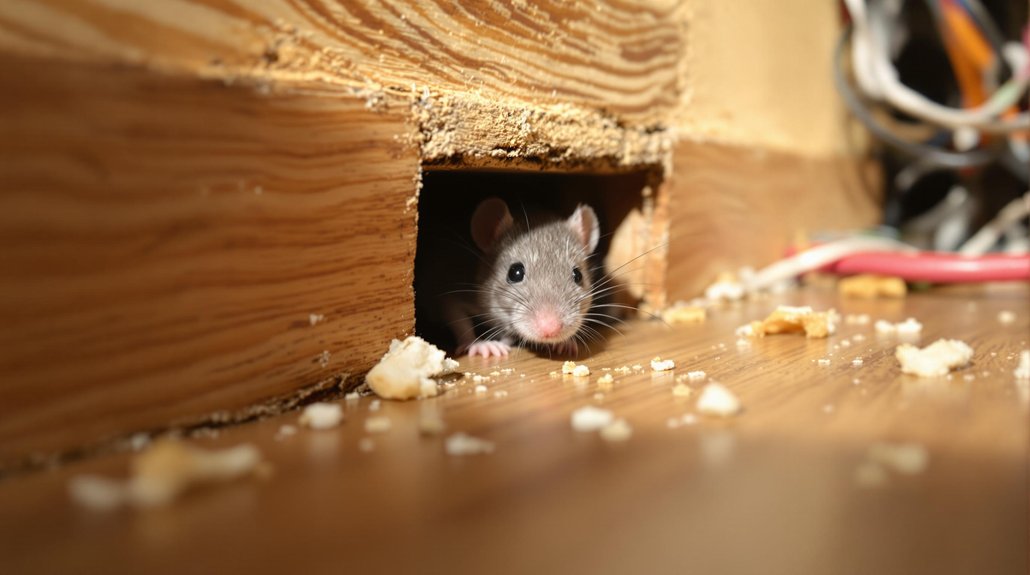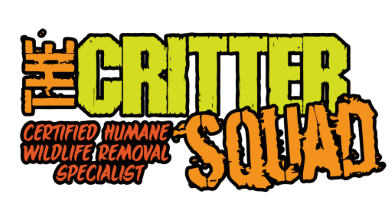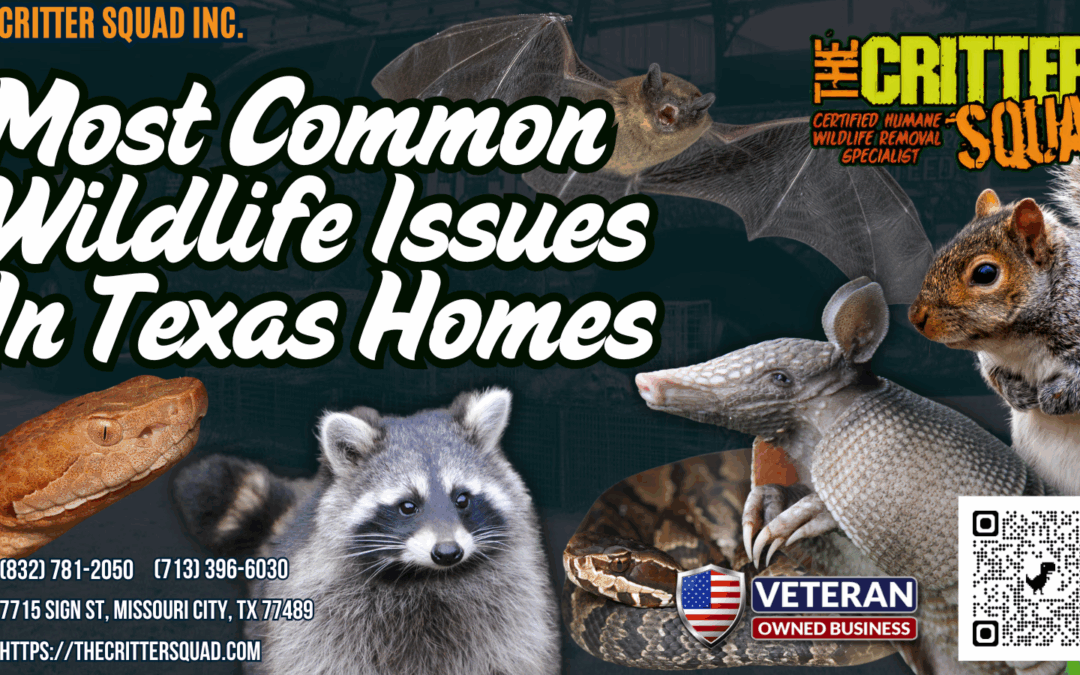Texas homes often deal with various wildlife issues. Raccoons rummage through trash, while snakes might surprise homeowners in the yard. Squirrels can invade attics, causing damage, and bats pose health risks as nocturnal neighbors. Coyotes, adapting to urban areas, can threaten pets. Armadillos dig up gardens, and rodents sneak in to nest and feed. Being aware of these wildlife problems is essential for prevention. There’s more to learn about managing these pesky visitors.
Key Article Highlights
- Raccoons are notorious for rummaging through trash and may invade attics, requiring humane trapping for control.
- Snakes, both venomous and non-venomous, can appear unexpectedly, necessitating safe identification and professional removal.
- Squirrels can cause significant damage to homes by chewing wires and insulation, making proactive control essential.
- Armadillos dig for food, creating holes in lawns and gardens, so barriers and repellents are effective deterrents.
- Coyotes adapt to urban settings, posing risks to pets, highlighting the need for community awareness and education.
Raccoons: The Trash Bandits
Many homeowners in Texas can relate to the sneaky antics of raccoons, often dubbed “trash bandits.” These clever creatures have a knack for rummaging through garbage bins, leaving a mess in their wake. Raccoons are known for their curious and intelligent behavior, often using their nimble paws to open lids and dig for food. They thrive in various habitats, from urban areas to wooded regions. Raccoons are nocturnal, making them more active at night when people are asleep. Their playful nature can make them entertaining but also a nuisance. Homeowners often find themselves trying to secure their trash to keep these furry scavengers at bay. Understanding raccoon behavior and habitats can help prevent unwanted visits and protect the home. Raccoon nesting habits also play a role in their tendency to invade attics and chimneys, further complicating control efforts. Employing humane raccoon trapping methods can effectively resolve issues without harming these animals.
Snakes: Slithering Intruders
Snakes can be an unsettling surprise for Texas homeowners. These slithering intruders often find their way into yards and sometimes even inside homes. Proper snake identification is key to staying safe. Texas is home to both non-venomous and venomous species, like rattlesnakes and copperheads. Knowing the difference can save a lot of worry. Homeowners should keep an eye out for snakes hiding in tall grass or under debris. It’s important to stay calm if a snake is spotted and to avoid approaching it. Instead, calling a professional can help safely remove the snake. Professional snake removal services, such as snake trapping and emergency snake removal, are equipped to get rid of snakes safely and effectively. By understanding these creatures, homeowners can enjoy their properties without fear and guarantee their homes remain snake-free.
Squirrels: Attic Invaders
Squirrels can be a big problem for Texas homeowners when they sneak into attics. Signs of their presence include noises, droppings, and chewed materials. It’s important to understand the damage they can cause and how to keep them out for good. Utilizing humane squirrel removal methods can effectively resolve infestations without harming the animals.
Signs of Infestation
When homeowners notice strange sounds coming from the attic, it could be a sign that unwelcome guests have moved in. Squirrels are often the culprits, and recognizing the infestation signs is key to addressing the problem. Homeowners should look out for these wildlife indicators:
- Scratching noises: Often heard during the day as squirrels are active.
- Droppings: Small, dark droppings can accumulate in corners or near entry points.
- Nesting materials: Chewed-up insulation or leaves can indicate nesting activity.
- Gnaw marks: Look for signs of gnawing on wood, wires, or ducts.
Identifying these signs early can help in taking action before the situation worsens. Squirrels may seem cute, but they can quickly become a nuisance.
Damage and Risks
A significant number of homes in Texas face damage and risks when squirrels invade attics. These furry pests can cause serious wildlife damage by chewing through wires, insulation, and wood. Their sharp teeth can easily create holes, leading to leaks and other property risks. Squirrels also leave droppings and urine behind, which can lead to health issues and bad odors. If they decide to nest, they can create a fire hazard with their nesting materials. Homeowners often find themselves facing costly repairs due to these little invaders. Ignoring the problem can result in bigger issues down the line, making it vital to address squirrel infestations before they escalate. Protecting the home from these risks is essential for peace of mind.
Prevention Strategies
Addressing squirrel infestations requires proactive measures to prevent these pests from invading attics in the first place. Homeowners can take simple steps to keep their homes safe. Effective strategies include:
- Habitat modification: Trim tree branches that hang close to the roof, making it harder for squirrels to jump onto the house.
- Wildlife proofing structures: Seal all entry points, like gaps and holes, to block access to attics.
- Remove food sources: Secure trash cans and avoid leaving pet food outside.
- Install squirrel guards: Use barriers on utility poles and chimneys to deter squirrels from climbing into your home.
With these methods, homeowners can protect their space and enjoy a squirrel-free attic.
Bats: Nocturnal Neighbors

Bats can be interesting to watch, but they can also bring some health risks to homes in Texas. It’s important for homeowners to know how to prevent bats from moving in and how to safely remove them if they do. Keeping homes bat-free is key to staying healthy and safe. Using humane bat removal techniques ensures that bats are removed safely without harming them or your property. Understanding bat behavior can help identify potential entry points and prevent infestations before they start.
Health Risks Associated
Many homeowners may not realize the health risks that come with sharing their space with bats. These nocturnal neighbors can carry wildlife diseases that pose threats to human health. Awareness is key, especially when considering the following risks:
- Rabies: A serious viral disease that can be fatal.
- Histoplasmosis: A respiratory disease caused by bat droppings.
- Bat Bugs: Pests that can infest homes and cause discomfort.
- Allergies: Bat guano can trigger allergic reactions in some individuals.
Effective pest control is essential to address these issues. By understanding the potential health risks associated with bats, homeowners can make informed decisions about managing their living environments and protecting their well-being.
Prevention and Exclusion
To prevent bats from making a home in residential spaces, homeowners should take proactive steps to secure their properties. Using effective exclusion techniques is key. This means sealing off entry points like gaps in walls or roofs where bats might sneak in. Habitat modification also plays an important role. Homeowners can trim back trees and remove standing water, making their yards less inviting to bats. Installing screens on vents and chimneys can further discourage these nocturnal neighbors from settling in. Regular inspections are essential to catch any potential issues early. By combining exclusion techniques with habitat modification, homeowners can enjoy their space without worrying about unwanted bat guests. Keeping homes bat-free leads to a more peaceful living environment.
Safe Removal Practices
When bats do find their way into homes, it’s important to handle their removal carefully. Following wildlife guidelines guarantees both safety and compassion. Using humane traps is a great way to relocate these nocturnal neighbors without harm. Here are some safe removal practices:
- Identify entry points to prevent future visits.
- Seal openings after bats have been removed.
- Use humane traps to capture bats without hurting them.
- Release them at dusk to help them find their way home.
Coyotes: Urban Encroachers
As urban areas expand, coyotes increasingly adapt to life in cities and suburbs. These clever animals show unique coyote behavior that helps them thrive in urban settings. They scavenge for food in trash cans and hunt small pets, taking advantage of the resources cities provide. Their urban adaptation allows them to blend into neighborhoods, often seen roaming parks or backyards at dusk. Coyotes are generally shy, but they can become bold in search of food. This change can lead to conflicts with residents. It’s important for homeowners to be aware of their presence and take steps to secure their properties. Understanding coyote behavior can help people coexist with these urban encroachers while maintaining their sense of freedom in their outdoor spaces.
Armadillos: Garden Diggers
Urban wildlife isn’t just limited to coyotes; armadillos are another common sight in Texas neighborhoods. These little creatures are known for their unique digging habits, which can be a real headache for gardeners. Understanding armadillo behavior can help homeowners take steps for garden protection.
Armadillos are common in Texas neighborhoods, and their digging habits can pose challenges for gardeners. Understanding them is key to garden protection.
- Armadillos dig to find food, like insects and grubs.
- They can create unsightly holes in lawns and flower beds.
- Their digging can disrupt plant roots, harming garden growth.
- Simple barriers or repellents can help keep them away.
- Recognizing armadillo activity signs early can prevent extensive yard damage.
Homeowners should be aware of armadillos and their habits. Taking action early can save gardens from damage and keep these critters at bay. A little knowledge goes a long way in protecting that cherished outdoor space!
Rodents: Unwanted House Guests

Rodents can be a major nuisance for many homeowners in Texas. These unwanted house guests often sneak in through tiny openings, looking for food and shelter. Their nesting habits can lead to serious damage in attics and walls. Homeowners may find chewed wires or droppings, which can pose health risks. Effective rodent control is essential to keep these pests at bay. Simple steps like sealing entry points, keeping food stored properly, and maintaining a clean environment can help. Traps and baits are useful, but for a big infestation, calling a professional might be necessary. Taking action early can save homeowners from headaches later on. Nobody wants to share their home with rodents, so staying vigilant is key.
Frequently Asked Questions
How Can I Prevent Wildlife From Entering My Home?
To prevent wildlife from entering, one should install wildlife barriers and practice preventive landscaping. This includes trimming plants and sealing entry points. Simple steps can create a home that feels safe and free from unwanted visitors.
What Should I Do if I Find a Baby Animal?
Finding a baby animal can be surprising. It’s important to assess its situation first. Research baby animal care and explore wildlife rehabilitation options. Often, it’s best to leave them be or contact a professional for help.
Are There Any Legal Protections for Native Wildlife in Texas?
In Texas, wildlife regulations protect many native species. These laws guarantee that animals are treated fairly and help maintain their populations. Understanding these rules is important for anyone interacting with Texas’s diverse wildlife.
How Can I Safely Remove Wildlife Without Harming Them?
When it comes to gently encouraging wildlife to leave, using humane traps can be a great option. After capturing them, contacting local wildlife rehabilitation can guarantee they are safely relocated, allowing them to thrive elsewhere.
What Time of Year Do Wildlife Issues Peak in Texas?
Wildlife issues in Texas often peak during spring and fall. Seasonal patterns affect wildlife behavior, as animals seek food and shelter. Homeowners should be aware of these times to prevent conflicts with local wildlife.

